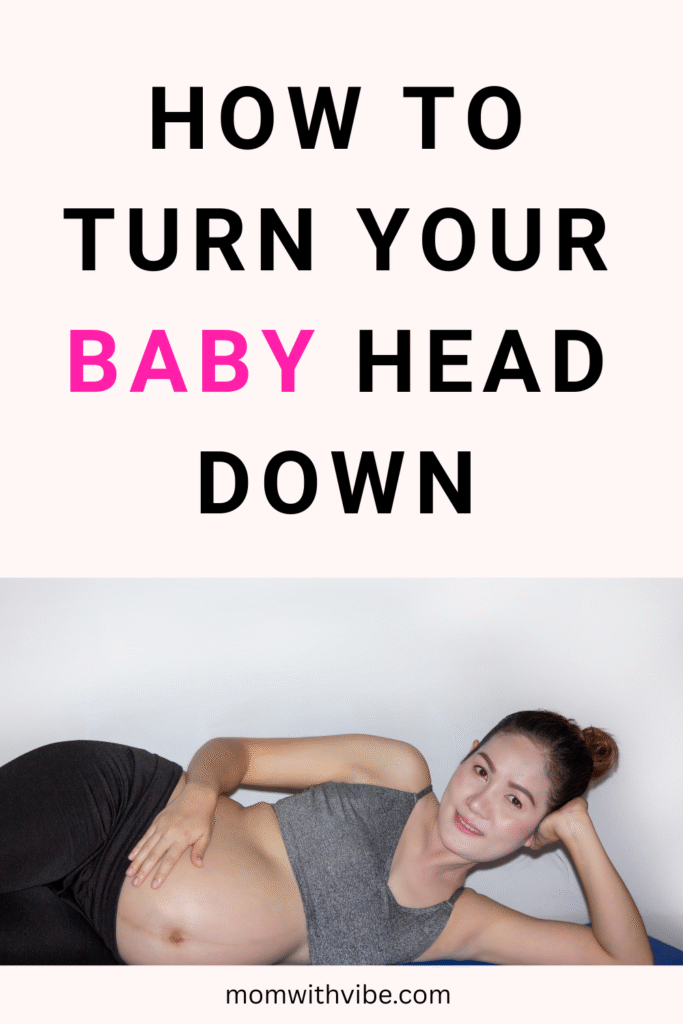Pregnancy is a roller coaster, full of both fear and excitement as you await the arrival of your newborn. However, when you are in the last weeks, you can get worried about one very important thing: the location of your baby. The ideal position is for the babies to be head down (which is called cephalic presentation) at the onset of labor. Nonetheless, a few babies might be in breech (bottom down) or transverse (lying sideways), indicating that delivery may not be easy.
Do not panic! If your baby is in the breech or transverse position as you approach your due date, it is possible to encourage your baby to turn head down with several gentle techniques, some of which have proven effective. Whether through simple exercises or professional methods, this guide will help you navigate ways to move your baby into the best position for delivery. Let’s jump in!

1. Spinning Babies Techniques: Gentle, Effective Exercises
Spinning Babies is one of the most popular methods to encourage your baby to turn head down. This method includes a series of exercises that focus on unstraining your muscles and lifting the pelvis to provide your baby with more space to move. Here are some of the Spinning Babies exercises:
- Forward-Leaning Inversion: This exercise involves an inclined position at a 45-degree angle to help your baby flip head down. To do this, kneel on something soft and lean forward with your hands touching the floor, allowing your head to drop lower than your hips. This technique works best with a partner or a trained professional to ensure you are safely held in position. You can use online tutorials or consult your doctor for further guidance. According to Spinning Babies, forward-leaning inversion may also improve your odds of delivering a head-down baby.
- Sidelying Release: This technique focuses on releasing tension in your pelvis. Lie on your left side with a pillow under your hips to allow your pelvis to relax and give your baby more space. After about 20 minutes, repeat the exercise on the other side. It’s a painless method that can be done at home without any special equipment.
- Pelvic Tilts: Pelvic tilts involve rocking your hips forward and back while on all fours or sitting on an exercise ball. This movement helps your baby turn and could encourage it to move into the head-down position. Repeating pelvic tilts several times a day keeps your pelvis open and relaxed, which is key to creating space for your baby to flip.
Resources:
- Spinning Babies Techniques offers a variety of exercises and guides to help turn a breech baby.
2. Webster Technique Chiropractic Care
Another method that has worked for many pregnant women is the Webster Technique, a specialized chiropractic adjustment that can help your baby turn. The technique focuses on realigning the pelvis and loosening the ligaments surrounding the uterus, which can enable your baby to move more freely.
The Webster Technique involves gentle adjustments to your lower back and pelvis to relieve tension. This method helps balance the ligaments holding the uterus, allowing your baby to move more freely. Many women report that their babies turn head-down after a few sessions of the Webster Technique. If you’re interested in trying it, look for a chiropractor trained in this method, as it requires specific knowledge of pregnancy.
This technique is particularly beneficial if you’re in the later stages of pregnancy and experiencing tension, which may be preventing your baby from turning on its own.
Resources:
- To learn more about the Webster Technique and locate a certified chiropractor, visit ICPA Websters.
Related: 10 Types of Housework Pregnant Women Should Avoid
3. Acupuncture and Moxibustion: Traditional Methods
Some pregnant women turn to acupuncture or moxibustion—a form of traditional Chinese medicine. Moxibustion involves burning a special herb near a specific point on your toe. This technique is believed to activate energy pathways in your body and may encourage your baby to turn.
While research results on acupuncture’s effectiveness are mixed, there’s enough anecdotal evidence to suggest that it may help some women. A study published in the Journal of Perinatal Medicine showed that acupuncture, in conjunction with moxibustion, might be effective in helping a breech baby turn to the right position.
Resources:
- Talk to a certified acupuncturist familiar with treating pregnancy. For an in-depth guide on moxibustion and acupuncture, refer to the Mayo Clinic’s Acupuncture Guide.
4. Get Moving: The Power of Movement
You may feel the urge to take it easy during pregnancy, but movement can actually help your baby turn into the right position. Activities like walking, swimming, or prenatal yoga can help open your hips and give your baby more room to move. Gravity can also work in your favor, stimulating movement that encourages your baby to flip to the head-down position.
Prenatal yoga is especially helpful, as it includes poses that focus on increasing flexibility and strength in your pelvis. Some yoga instructors will guide you through specific poses to improve fetal positioning. For example, poses like cat-cow and pelvic rocks can help rock your pelvis, which in turn can encourage your baby to turn. If you don’t already practice yoga, it’s best to consult with a professional or attend a prenatal class to ensure you’re practicing safely.
Resources:
- Visit your local studio or check out Gaiam’s Prenatal Yoga Classes.
5. External Cephalic Version (ECV): A Medical Option
If your baby is still breech after trying all these methods, your doctor may recommend External Cephalic Version (ECV). This procedure involves your doctor or midwife using their hands to massage your abdomen in an attempt to turn the baby.
ECV is typically performed in a hospital setting under ultrasound guidance and is usually done after 37 weeks. While it’s not guaranteed, many women find it effective. There are some risks associated with ECV, including premature rupture of membranes or placental abruption, but it is generally a safe procedure for most women.
It’s important to have a thorough discussion with your healthcare provider about the potential risks and benefits of ECV before deciding whether it’s right for you.
Resources:
- Learn more about ECV by visiting the American Pregnancy Association.
6. Patience and Positivity: Believing in the Process
It’s natural to feel anxious about your baby’s position, but many babies turn on their own in the final weeks of pregnancy. Stress can cause your body to tense up, which might make it harder for your baby to move into the right position. Focus on staying calm and giving yourself grace—trust the process.
Research shows that about 80% of breech babies turn head down by 36 weeks. So don’t lose hope if your baby isn’t head down yet. A little patience, positivity, and the right support can help your baby find the right position when the time is right.
Final Thoughts
Getting your baby into the right position for delivery doesn’t always happen automatically, but the right mix of methods can increase your chances. Whether you try Spinning Babies exercises, acupuncture, or the Webster Technique, the goal is to provide your baby with space and relaxation to move into the correct position.
Always consult with your healthcare provider before trying any new techniques to ensure you’re making the best choice for you and your baby. Stay patient, stay calm, and above all, stay positive. You’re doing great!
Resources:
Stay informed, and best of luck as you await the arrival of your baby!
FAQ: Frequently Asked Questions on Baby Turning Head Down
Q: What happens when my baby is breech or head down?
A: During routine check-ups, an ultrasound scan or manual checks by your doctor or midwife will monitor the position of the baby. Feel free to ask your doctor about your baby’s position during visits if you’re uncertain.
Q: Is it possible to practice these methods at home?
A: Yes! Exercises like pelvic tilts, sidelying release, and walking can be performed at home. However, methods like the Webster Technique or moxibustion should be done with the help of a professional.
Q: What happens when my due date arrives and my baby is not turned head down?
A: If your baby hasn’t turned by the time you’re near your due date, your healthcare provider will likely recommend an External Cephalic Version (ECV) or possibly a cesarean section.
Q: Does attempting to turn my baby have any risk of harm?
A: Most methods are safe, but it’s always important to consult your healthcare provider before trying any technique. ECV does carry risks, but your doctor will guide you through the process safely.
Q: Will my baby someday turn itself?
A: Many babies will naturally turn head down in the weeks leading up to labor. About 80% of breech babies will turn by 36 weeks. Stay positive and trust your body!
Q: Will it still be possible to deliver vaginally if my baby doesn’t turn?
A: If your baby remains breech or transverse, a vaginal delivery may not be recommended. Your doctor will discuss the best options for safe delivery, including cesarean section.
Don’t hesitate to consult with your healthcare provider for more specific questions or concerns!
Save the pin for later




